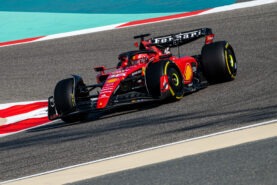Ferrari SF-23 specs & info
Ferrari's F1 car for 2023
The SF-23, whose name marks a return to the format of the Scuderia Ferrari initials combined with the year of competition, as has been the case for most of the hybrid era, was first seen on video. But then came the announcement that, for the first time since 2017, the car would actually take to the track on launch day.
Which of the two drivers would get behind the wheel first was decided by Fred Vasseur tossing a special coin, with Leclerc’s and Sainz’s race numbers- 16 and 55 – one on each side. Charles won and drove the SF23 for its first couple of laps, while Carlos got his turn shortly afterwards.
Special livery. The SF-23 livery features some parts in naked carbon, while the historic “long F” logo appears on the rear wing. The red colour is also brand new, created by Ferrari Design: a matt version on the Formula 1 car, and glossy on the 499P Hypercar, which makes its endurance racing debut this year.
Technical specifications Ferrari SF-23 F1 car
Chassis made from carbon fibre composite honeycomb, with halo protection for the cockpit.
Longitudinal Ferrari gearbox with 8 forward gears and reverse
Hydraulically controlled rear differential
Brembo ventilated carbon discs (front and rear) with electronically controlled rear brakes
Push-rod front suspension, pull-rod rear suspension
Weight including coolant, oil and driver: 798 kg
18” front and rear wheels
Bodywork and seat in carbon fibre
Power unit
Name: 066/10
Cubic capacity: 1600 cc
Maximum rpm: 15,000
Supercharging: single turbocharger
Maximum fuel flow rate: 100 kg/hr
Maximum race fuel 110 kg
Configuration: 90° V6
Bore: 80 mm
Stroke: 53 mm
4 valves per cylinder
Direct injection, max 500 bar
ERS System
Configuration: hybrid energy recovery system with electric motor generators
Battery pack: Lithium-ion batteries with a minimum weight of 20 kg
Maximum battery pack capacity: 4 MJ
MGU-K maximum power: 120 kW (163cv)
MGU-K maximum rpm: 50,000
MGU-H maximum rpm: 125,000












LAST 3 F1 Fan COMMENTS